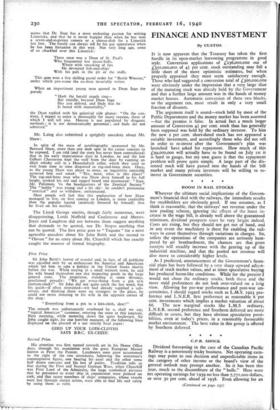BOOM IN RAIL STOCKS Whatever the ultimate social implications of
the Govern- ment's financial deal with the railways, the immediate results for stockholders are obviously good. If one assumes, as I think is reasonable, that the railways' net revenue under the new pooling scheme, ignoring the effects of the latest in- crease in the wage bill, is already well above the guaranteed minimum, dividend prospects must be very bright indeed. Costs are rising, but they should not get out of hand, and in any event the machinery is there for enabling the rail- ways to cover themselves through variations in charges. So, unless the operations of the companies are seriously ham- pered by air bombardment, the chances are that gross receipts will steadily increase with the gearing up of the industrial machine, and that the pooled net revenue will also move to considerably higher levels.
As I predicted, announcement of the Government's finan- cial plans has been followed by a very sharp upward adjust- ment of stock market values, and at times speculative buying has produced boom-like conditions. While for the presentl would not chase the ordinary stocks, both these and • the more staid preferences do not look over-valued on a long view. Allowing for pre-war performance and post-war un- certainties, I should regard stocks such as L.M.S. 1923 pre- ference and L.N.E.R. first preference as reasonable 6 per cent. investments which implies a market valuation of about 66. The new marginal stocks like L.M.S ordinary, L.N.E.R. second preference and Southern deferred are more difficult to assess, but they have obvious speculative possi- bilities, even at today's prices, in a reasonably favourable market environment. The best value in this group is offered by Southern deferred.






































 Previous page
Previous page